AMD Zen 3 Ryzen Deep Dive Review: 5950X, 5900X, 5800X and 5600X Tested
by Dr. Ian Cutress on November 5, 2020 9:01 AM ESTCPU Tests: Simulation
Simulation and Science have a lot of overlap in the benchmarking world, however for this distinction we’re separating into two segments mostly based on the utility of the resulting data. The benchmarks that fall under Science have a distinct use for the data they output – in our Simulation section, these act more like synthetics but at some level are still trying to simulate a given environment.
DigiCortex v1.35: link
DigiCortex is a pet project for the visualization of neuron and synapse activity in the brain. The software comes with a variety of benchmark modes, and we take the small benchmark which runs a 32k neuron/1.8B synapse simulation, similar to a small slug.
The results on the output are given as a fraction of whether the system can simulate in real-time, so anything above a value of one is suitable for real-time work. The benchmark offers a 'no firing synapse' mode, which in essence detects DRAM and bus speed, however we take the firing mode which adds CPU work with every firing.
The software originally shipped with a benchmark that recorded the first few cycles and output a result. So while fast multi-threaded processors this made the benchmark last less than a few seconds, slow dual-core processors could be running for almost an hour. There is also the issue of DigiCortex starting with a base neuron/synapse map in ‘off mode’, giving a high result in the first few cycles as none of the nodes are currently active. We found that the performance settles down into a steady state after a while (when the model is actively in use), so we asked the author to allow for a ‘warm-up’ phase and for the benchmark to be the average over a second sample time.
For our test, we give the benchmark 20000 cycles to warm up and then take the data over the next 10000 cycles seconds for the test – on a modern processor this takes 30 seconds and 150 seconds respectively. This is then repeated a minimum of 10 times, with the first three results rejected. Results are shown as a multiple of real-time calculation.
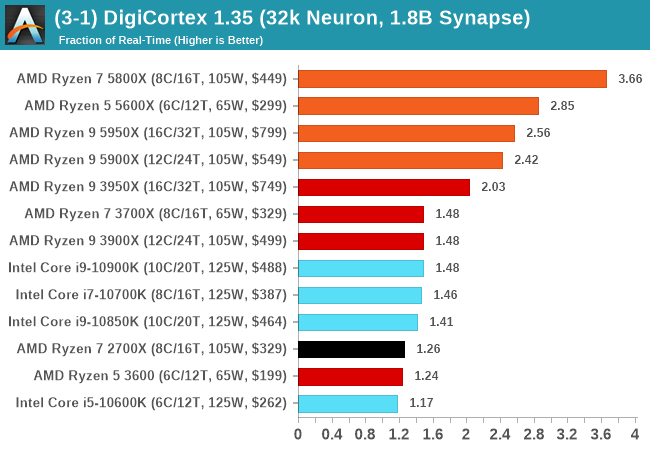
Dwarf Fortress 0.44.12: Link
Another long standing request for our benchmark suite has been Dwarf Fortress, a popular management/roguelike indie video game, first launched in 2006 and still being regularly updated today, aiming for a Steam launch sometime in the future.
Emulating the ASCII interfaces of old, this title is a rather complex beast, which can generate environments subject to millennia of rule, famous faces, peasants, and key historical figures and events. The further you get into the game, depending on the size of the world, the slower it becomes as it has to simulate more famous people, more world events, and the natural way that humanoid creatures take over an environment. Like some kind of virus.
For our test we’re using DFMark. DFMark is a benchmark built by vorsgren on the Bay12Forums that gives two different modes built on DFHack: world generation and embark. These tests can be configured, but range anywhere from 3 minutes to several hours. After analyzing the test, we ended up going for three different world generation sizes:
- Small, a 65x65 world with 250 years, 10 civilizations and 4 megabeasts
- Medium, a 127x127 world with 550 years, 10 civilizations and 4 megabeasts
- Large, a 257x257 world with 550 years, 40 civilizations and 10 megabeasts
DFMark outputs the time to run any given test, so this is what we use for the output. We loop the small test for as many times possible in 10 minutes, the medium test for as many times in 30 minutes, and the large test for as many times in an hour.
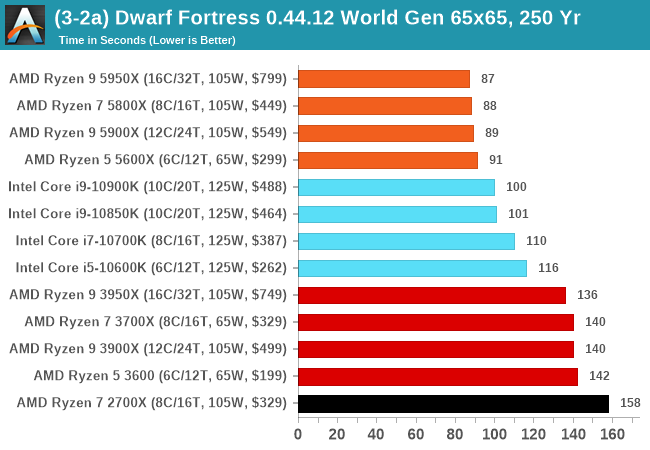
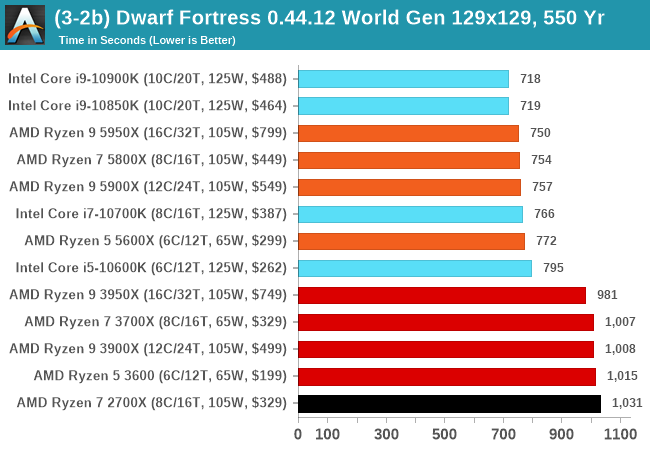
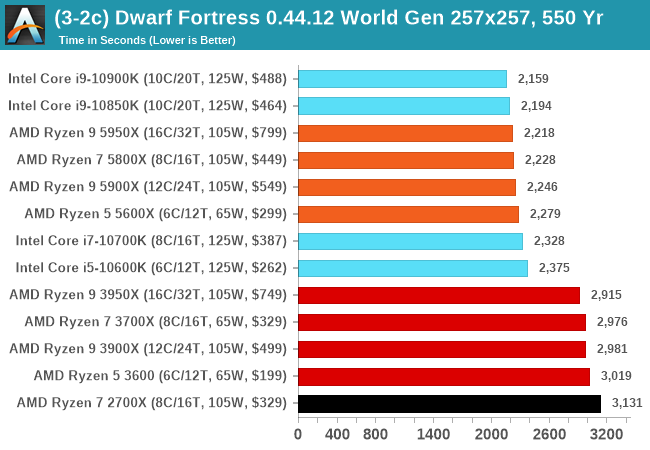
Dolphin v5.0 Emulation: Link
Many emulators are often bound by single thread CPU performance, and general reports tended to suggest that Haswell provided a significant boost to emulator performance. This benchmark runs a Wii program that ray traces a complex 3D scene inside the Dolphin Wii emulator. Performance on this benchmark is a good proxy of the speed of Dolphin CPU emulation, which is an intensive single core task using most aspects of a CPU. Results are given in seconds, where the Wii itself scores 1051 seconds.
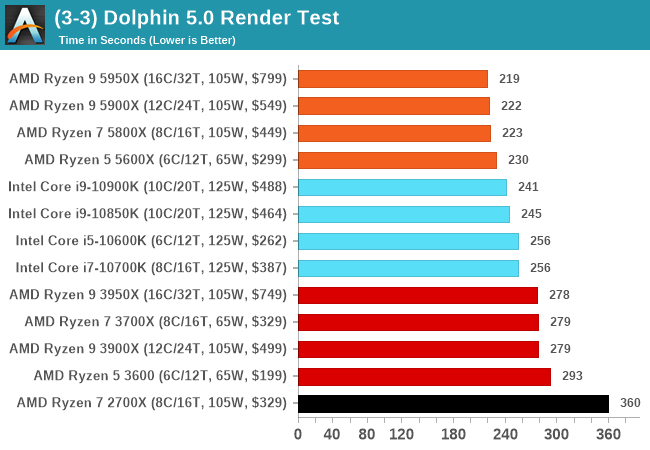












339 Comments
View All Comments
GeoffreyA - Thursday, November 5, 2020 - link
Battling to load the article for hours, but looks like it's finally working. On page 3 now.GeoffreyA - Friday, November 6, 2020 - link
Thanks for the excellent analysis, AT. Zen 3 has delivered, even more than expected. Brings back memories of the Athlon 64 FX-51 at the top of charts and later the Core 2 Duo, which left K8 dead on the floor. I am impressed by the IPC's having gone up so much but power remaining roughly the same. And, besides the widening, surprisingly conservative, there are a lot of "intelligent" techniques bringing about improvement (reminiscent of the Pentium M in a way). All in all, outstanding work from AMD. The engineers deserve a round of applause.GeoffreyA - Saturday, November 7, 2020 - link
Ian, not sure if I missed it, but what version of Windows does the test suite use? The CPU overload article says 1909. According to Techpowerup, there have been some scheduler changes since 1903 and the difference in performance was a few per cent. for Zen 3. Thanks.https://www.techpowerup.com/review/amd-ryzen-9-590...
mjcutri - Thursday, November 5, 2020 - link
Was pleasantly surprised that I was able to pick up a 5600x from newegg this morning. It'll be a nice upgrade from my i7-3920 that I've been running for 8 years!lmcd - Thursday, November 5, 2020 - link
The thing that's so funny to me is how well Sandy Bridge E has held up. Nearly every board supports PCIe 3.0 and SATA III, quad-channel memory means it's not memory bound, and it clocks up quite well.Obviously performance per watt sucks and it doesn't game as well anymore, but the feature set is way more usable than I'd ever have expected 8 years later.
Spunjji - Sunday, November 8, 2020 - link
It was a really solid platform. Throw in an SSD on PCIe and you wouldn't miss an awful lot from a more modern system, but it looks like that point has finally been reached... 8 years later!lmcd - Monday, November 9, 2020 - link
I wish both Intel and AMD would bring prosumer platforms back. While obviously SLI and XF are dead, PCIe lanes are nice to have and I/O futureproofing is actually impossible anymore.Qasar - Tuesday, November 10, 2020 - link
id just like to see more PCIe lanes. maybe 8-16 more ?Vitor - Thursday, November 5, 2020 - link
The craziest thing is that AMD has a very easy upgrade path with 5nm being avaible.CrystalCowboy - Thursday, November 5, 2020 - link
5 nm, DDR5, PCIe 5, USB4. These are all obvious future developments. They will do a new socket for that; will be interesting to see what they do with that.